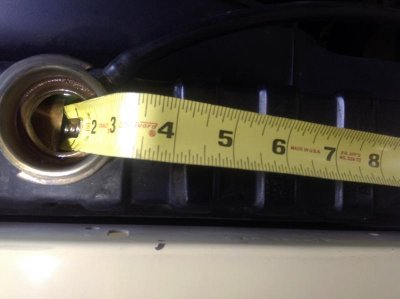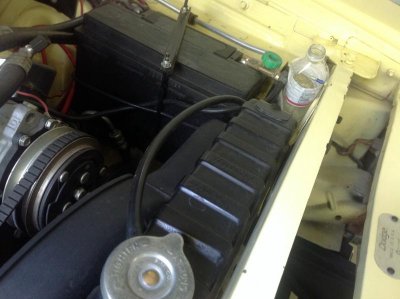You are using an out of date browser. It may not display this or other websites correctly.
You should upgrade or use an alternative browser.
You should upgrade or use an alternative browser.
let's see your coolant tanks
- Thread starter 747mopar
- Start date
ODZKing
Well-Known Member
It is not a closed system so it is not for recycling the fluid.I still want to know why anyone with a pre 70 needs one?
For me, I just got tired of it puking at the most embarrassing time like when you pull in at a car show. That's all.
440+6
Well-Known Member
I used an old valvoline oil quart (after cleaning it out thoroughly, of course) and drilled out for a grommet in the cap. works like a charm!! it fits perfectly between the rad core and the battery tray and it cost me $0
I did the same as mar except with a brake fluid bottle, only reason it's there is the drag strip required it, never saw any coolant come out of the hose.
themechanic
Oklahoma is OK
- Local time
- 11:45 AM
- Joined
- Nov 11, 2012
- Messages
- 21,941
- Reaction score
- 28,254
- Location
- Moore, Oklahoma
It is not a closed system so it is not for recycling the fluid.
For me, I just got tired of it puking at the most embarrassing time like when you pull in at a car show. That's all.
X2
Filled rad, it ran then puked, filled rad, it ran then puked, I read FBBO forums, filled rad to 2" below neck, it ran then puked, installed tank, problem solved.
Grabinov911
Well-Known Member
It is not a closed system so it is not for recycling the fluid.
For me, I just got tired of it puking at the most embarrassing time like when you pull in at a car show. That's all.
So guys I have a question: I am currently NOT running a tank, but have been considering it. I WAS running a radiator cap with a thermometer in it - kinda neat - but I noticed that the upper radiator hose became seriously pressurized (meaning the whole system did) when the car was running. With that cap I figure the overflow tank would have done nothing as the cap was not allowing any fluid to reach the escape hole in the neck of the radiator.
I switched back to a factory-style radiator cap and voila, no pressurized radiator hose. I assume in this circumstance the cap WOULD allow fluid to pass into a tank.
Which is correct? Is the cap supposed to be essentially "open" like that so fluid can pass to a tank? Would it then be sucked back into the radiator as it cooled as in modern systems?
Thanks
themechanic
Oklahoma is OK
- Local time
- 11:45 AM
- Joined
- Nov 11, 2012
- Messages
- 21,941
- Reaction score
- 28,254
- Location
- Moore, Oklahoma
Yes, that's the way my recirculating can works. Some are just catch cans for overflow only.


If kept at this level, it has never purged. Think Reno in August. 107 degrees. Parade idling. Like my recovery tank? Only for drag racing tech inspection. OK, maybe it is 2 inches,plus a fraction. Depends how much you drive your car. Mine gets regular use. The Chevy guys at shows can't resist topping it off and usually piss a bunch when parked.
kb67mopar
Well-Known Member
A recovery bottle is typically used when the radiator is designed to fill to the top and not contain expansion space. This requires a double seal cap which allows fluid to push past the first seal at a set pressure and into the recovery bottle. Once the liquid has cooled a vacuum will form and pull it back into the radiator if the line is plumbed into the bottom of the recovery bottle. If the system does not need that quantity of fluid or was designed without a recovery bottle, chances are the area in the radiator that is empty is there as expansion space and a recovery bottle is not needed. However, the benefit of having a working recovery bottle is that if you do overheat you will not lose the coolant and it will pull fluid back in to counteract a small leak.
So the long answer is, if you are running a stock radiator with a stock engine you do not need a recovery bottle. If you modify things and use a different style radiator then look at the way its designed. However, most automotive applications pre-emissions regs never used recovery.
So the long answer is, if you are running a stock radiator with a stock engine you do not need a recovery bottle. If you modify things and use a different style radiator then look at the way its designed. However, most automotive applications pre-emissions regs never used recovery.
I started this thread because just like you guys are saying my car pukes after driving it (not very attractive). Like some are saying once it gets down about 2 inches it's fine and doesn't puke anymore but I think it makes sense to put a recovery tank on it so it's always full instead of running it low all the time. I'm running a BeCool radiator with side tanks meaning the top few rows are doing nothing if it's 2 inches low so that's my reasoning. So to me I'm thinking side tanks need to be full and radiators with top & bottom tanks can be ran low with almost no affect on cooling as long as there's enough coolant to keep the cores full. Thanks again for all the input
kb67mopar
Well-Known Member
I started this thread because just like you guys are saying my car pukes after driving it (not very attractive). Like some are saying once it gets down about 2 inches it's fine and doesn't puke anymore but I think it makes sense to put a recovery tank on it so it's always full instead of running it low all the time. I'm running a BeCool radiator with side tanks meaning the top few rows are doing nothing if it's 2 inches low so that's my reasoning. So to me I'm thinking side tanks need to be full and radiators with top & bottom tanks can be ran low with almost no affect on cooling as long as there's enough coolant to keep the cores full. Thanks again for all the input
I would agree and its environmentally responsible :toothy4:















